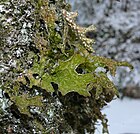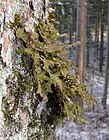Note: This is a project under development. The articles on this wiki are just being initiated and broadly incomplete. You can Help creating new pages.
Difference between revisions of "Lobaria pulmonaria - Tree lungwort"
| Line 1: | Line 1: | ||
[[File:Lobaria pulmonaria 010108a.jpg|thumb|right|''Lobaria pulmonaria'']] | [[File:Lobaria pulmonaria 010108a.jpg|thumb|right|''Lobaria pulmonaria'']] | ||
'''Lobaria pulmonaria''' is a large epiphytic lichen consisting of an ascomycete fungus and a green algal partner living together in a symbiotic relationship with a cyanobacterium symbiosis involving members of three kingdoms of organisms. | '''Lobaria pulmonaria''' is a large epiphytic lichen consisting of an ascomycete fungus and a green algal partner living together in a symbiotic relationship with a cyanobacterium symbiosis involving members of three kingdoms of organisms. | ||
| − | |||
==Uses== | ==Uses== | ||
{{Uses|Coughing}}, {{Uses|Catarrh}}, {{Uses|Asthma}}, {{Uses|Tuberculosis}}, {{Uses|Burns}}, {{Uses|Ulcers}}, {{Uses|Pimples}}, {{Uses|Hemorrhoids}}, {{Uses|Eczema}}. | {{Uses|Coughing}}, {{Uses|Catarrh}}, {{Uses|Asthma}}, {{Uses|Tuberculosis}}, {{Uses|Burns}}, {{Uses|Ulcers}}, {{Uses|Pimples}}, {{Uses|Hemorrhoids}}, {{Uses|Eczema}}. | ||
| Line 9: | Line 8: | ||
==Chemical Composition== | ==Chemical Composition== | ||
| − | + | Sticinic, norstitic, gyrophoric, thelophoric and related acids; fatty acids (including palmitic.<ref name="chemical composition"/> | |
==Common names== | ==Common names== | ||
| Line 38: | Line 37: | ||
===Flower=== | ===Flower=== | ||
| − | {{Flower|Unisexual|2-4cm long| | + | {{Flower|Unisexual|2-4cm long|Blue and pink|5-20|Flowers Season is June - August}} |
===Fruit=== | ===Fruit=== | ||
| − | {{Fruit||7–10 mm (0.28–0.4 in.) long pome| | + | {{Fruit||7–10 mm (0.28–0.4 in.) long pome|Clearly grooved lengthwise, Lowest hooked hairs aligned towards crown|With hooked hairs|}} |
===Other features=== | ===Other features=== | ||
| Line 53: | Line 52: | ||
==How to plant/cultivate== | ==How to plant/cultivate== | ||
| − | When planting lungworts in your garden, keep in mind that these plants do best in shady, moist (but not swampy) locations<ref name="How to plant/cultivate"/> | + | When planting lungworts in your garden, keep in mind that these plants do best in shady, moist (but not swampy) locations.<ref name="How to plant/cultivate"/> |
==Commonly seen growing in areas== | ==Commonly seen growing in areas== | ||
| Line 73: | Line 72: | ||
<references> | <references> | ||
| − | <ref name="chemical composition">[http://www.purplesage.org.uk/profiles/lungwort.htm | + | <ref name="chemical composition">[http://www.purplesage.org.uk/profiles/lungwort.htm Constituents]</ref> |
| − | <ref name="Leaf">[https://www.thespruce.com/pulmonaria-1402859 | + | <ref name="Leaf">[https://www.thespruce.com/pulmonaria-1402859 Plant decsription]</ref> |
| − | <ref name="How to plant/cultivate">[https://www.gardeningknowhow.com/ornamental/flowers/lungwort/growing-lungwort-flower.htm | + | <ref name="How to plant/cultivate">[https://www.gardeningknowhow.com/ornamental/flowers/lungwort/growing-lungwort-flower.htm How to Grow Lungwort]</ref> |
</references> | </references> | ||
Revision as of 11:07, 5 June 2020
Lobaria pulmonaria is a large epiphytic lichen consisting of an ascomycete fungus and a green algal partner living together in a symbiotic relationship with a cyanobacterium symbiosis involving members of three kingdoms of organisms.
Contents
- 1 Uses
- 2 Parts Used
- 3 Chemical Composition
- 4 Common names
- 5 Properties
- 6 Habit
- 7 Identification
- 8 List of Ayurvedic medicine in which the herb is used
- 9 Where to get the saplings
- 10 Mode of Propagation
- 11 How to plant/cultivate
- 12 Commonly seen growing in areas
- 13 Photo Gallery
- 14 References
- 15 External Links
Uses
Coughing, Catarrh, Asthma, Tuberculosis, Burns, Ulcers, Pimples, Hemorrhoids, Eczema.
Parts Used
Chemical Composition
Sticinic, norstitic, gyrophoric, thelophoric and related acids; fatty acids (including palmitic.[1]
Common names
| Language | Common name |
|---|---|
| Kannada | |
| Hindi | |
| Malayalam | |
| Tamil | |
| Telugu | |
| Marathi | NA |
| Gujarathi | NA |
| Punjabi | NA |
| Kashmiri | NA |
| Sanskrit | |
| English | Tree Lungwort, Oak Lungs |
Properties
Reference: Dravya - Substance, Rasa - Taste, Guna - Qualities, Veerya - Potency, Vipaka - Post-digesion effect, Karma - Pharmacological activity, Prabhava - Therepeutics.
Dravya
Rasa
Guna
Veerya
Vipaka
Karma
Prabhava
Habit
Identification
Leaf
| Kind | Shape | Feature |
|---|---|---|
| Simple | Oval | Leaves can be solid green, of varying intensities, or variegated with spots or splashes of white |
Flower
| Type | Size | Color and composition | Stamen | More information |
|---|---|---|---|---|
| Unisexual | 2-4cm long | Blue and pink | 5-20 | Flowers Season is June - August |
Fruit
| Type | Size | Mass | Appearance | Seeds | More information |
|---|---|---|---|---|---|
| 7–10 mm (0.28–0.4 in.) long pome | Clearly grooved lengthwise, Lowest hooked hairs aligned towards crown | With hooked hairs | {{{6}}} |
Other features
List of Ayurvedic medicine in which the herb is used
- Vishatinduka Taila as root juice extract
Where to get the saplings
Mode of Propagation
How to plant/cultivate
When planting lungworts in your garden, keep in mind that these plants do best in shady, moist (but not swampy) locations.[3]
Commonly seen growing in areas
Moist grasslands, Damp woods, Hedgerows.
Photo Gallery
References
External Links
- Ayurvedic Herbs known to be helpful to treat Coughing
- Ayurvedic Herbs known to be helpful to treat Catarrh
- Ayurvedic Herbs known to be helpful to treat Asthma
- Ayurvedic Herbs known to be helpful to treat Tuberculosis
- Ayurvedic Herbs known to be helpful to treat Burns
- Ayurvedic Herbs known to be helpful to treat Ulcers
- Ayurvedic Herbs known to be helpful to treat Pimples
- Ayurvedic Herbs known to be helpful to treat Hemorrhoids
- Ayurvedic Herbs known to be helpful to treat Eczema
- Herbs with Leaves used in medicine
- Herbs with Dried thallus used in medicine
- Herbs with common name in English
- Habit - Tree
- Index of Plants which can be propagated by Seeds
- Herbs that are commonly seen in the region of Moist grasslands
- Herbs that are commonly seen in the region of Damp woods
- Herbs that are commonly seen in the region of Hedgerows
- Herbs








